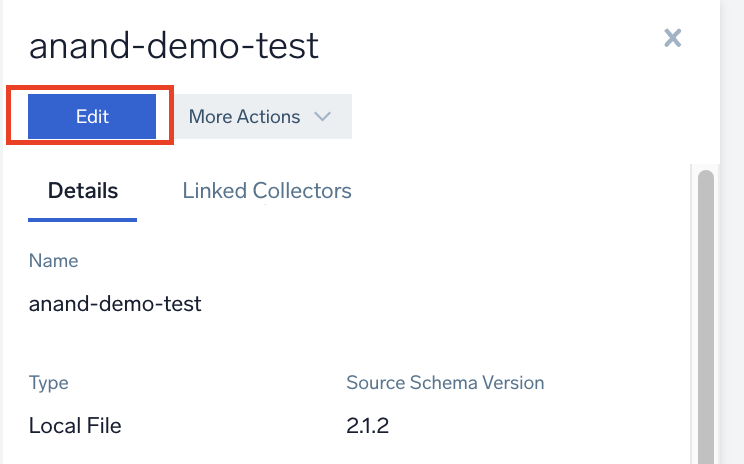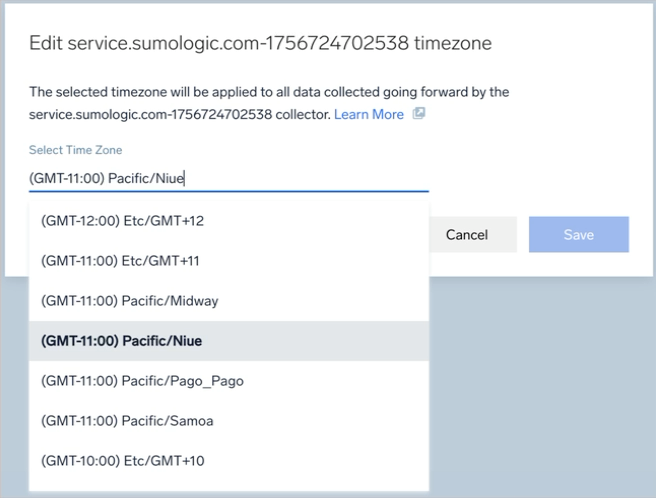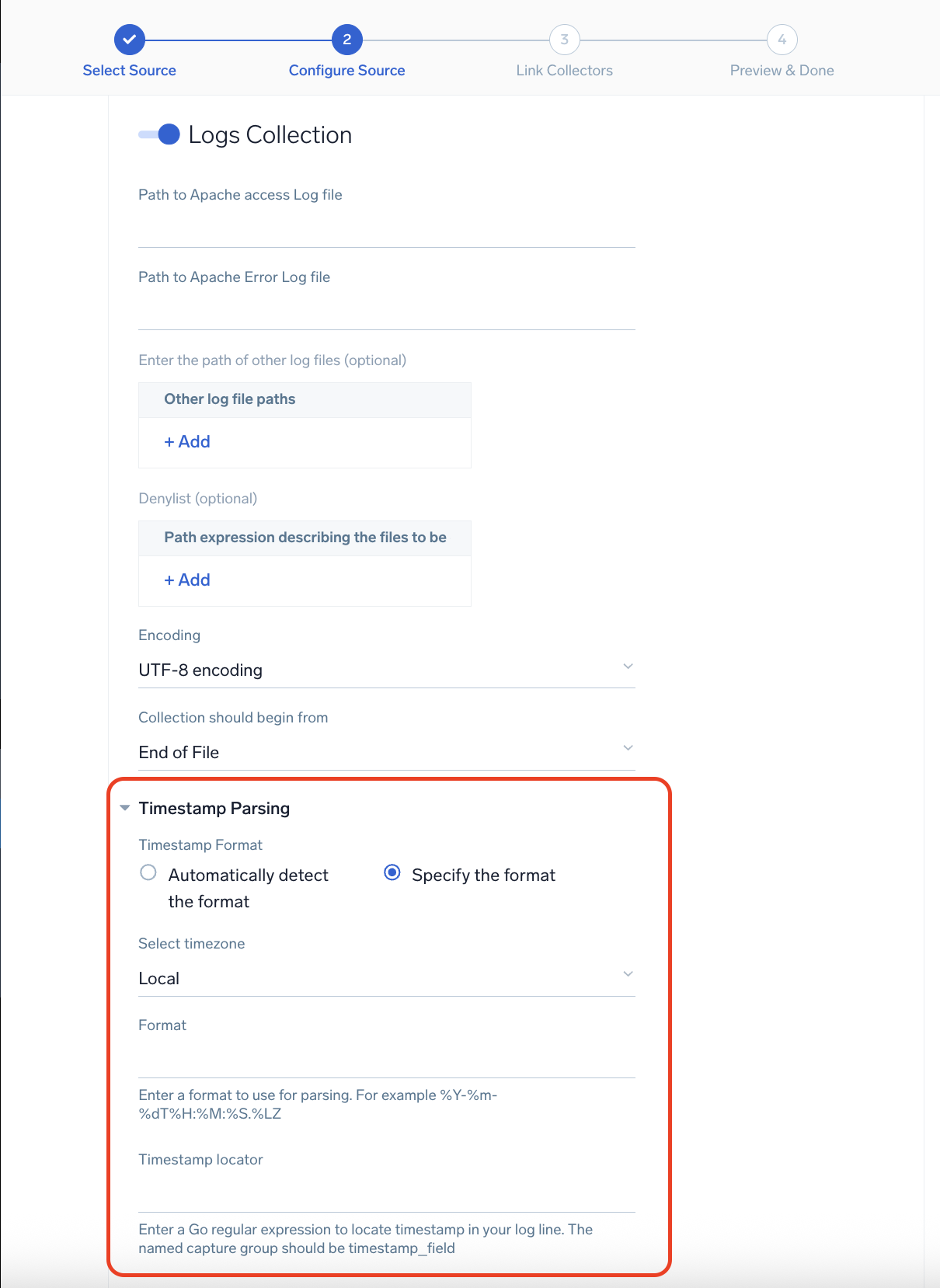Timestamps, Time Zones, Time Ranges, and Date Formats for OpenTelemetry Remote Management
We support several options for handling timestamps, time zones, and date formats in logs ingested through our OpenTelemetry Remote Management (OTRM) source templates.
This guide covers timestamp parsing behavior, configuration, and troubleshooting specific to OTRM. If you're using traditional Sumo Logic sources (not OTRM), refer to the general Time Reference documentation.
When collecting log data, the timestamp attached to messages is critical for data integrity and accurate search results. Sumo Logic indexes the timestamp of each message to ensure results fall within the query’s time range, allowing you to reconstruct event timelines reliably.
Timestamps
Timestamp is the part of a log message that marks the time that an event occurred. During ingestion, we can detect the message timestamp, convert it to Unix epoch time (the number of milliseconds since midnight, January 1, 1970 UTC), and index it. The timestamp is parsed either using the default timestamp parsing settings, or a custom format that you specify, including the time zone.
When configuring a source template, you can specify a custom format to parse timestamps in your log messages.
Currently, only strptime timestamps are supported in the source templates.
Timestamp considerations
By default, we can automatically detect timestamps in your log messages. Automatic detection identifies timestamps in common formats and prefers timestamps that appear early in the message.
If your log messages from a source contain multiple timestamps, timestamps in unusual formats, or a mix of distinct timestamp formats, you have two options:
- Configure a Source template for each log format.
- Configure a custom timestamp format for your Source template.
Specifying a custom timestamp format and time zone
OpenTelemetry Collectors can automatically parse most timestamps without any issues. However, if you see timestamp parsing issues, you can manually specify the timestamp format in the Sumo Logic UI when configuring a new Source template or editing the timestamp information for an existing Source template.
- Perform one of the following steps:
- If you're configuring a new Source template, proceed to Step 2. Or,
- To edit the timestamp settings for an existing Source template, navigate to the source template. Then click Edit to the right of the Source name and go to Step 2.

- Navigate to the Timestamp Parsing section and select Specify the format and enter the below details:
- Select Time Zone. Select the timezone of your choice from the drop-down while parsing a timestamp. By default, the timezone is set to
(UTC) Etc/UTC. The available locations depend on the local IANA Time Zone database. For more examples, refer to the List of tz database time zones. note
noteEnsure that the OpenTelemetry collector is enabled to edit the timezone.
- Format. Specify the exact layout of the timestamp to be parsed. For example,
- %Y-%m-%dT%H:%M:%S.%LZ. To learn more about the formatting rules, refer to this guide. - Timestamp locator. Use a Go regular expression to match the timestamp in your logs. Ensure the regular expression includes a named capture group called
timestamp_field.
- Select Time Zone. Select the timezone of your choice from the drop-down while parsing a timestamp. By default, the timezone is set to
Using _format for troubleshooting
You can use _format to see how the timestamp is parsed from the log file. Assign _format an alias to return it in your search results, for example:
| _format as timestampFormat
The fields returned in the search results of _format are:
t:<parse type>,o:<offset>,l:<length>,p:<date_format>
where <parse type> can take the below mentioned values:
fail. Failed to locate timestamp.cache. Success, cached format.def. Success, default (user-specified) format.full. Success, from "full" parsing against library of patterns.none. Local/receipt time because timestamp parsing is not enabled for this source.ac1. Auto-corrected by the "window-based" heuristic (what we call "auto-correction" today). Sumo Logic assumes that all log messages coming from a particular Source will have timestamps that are close together. If a message comes through that appears to be more than one day earlier or later than recent messages from that source, it will be auto-corrected to match the current time. You can stop this auto-correction by explicitly configuring a custom timestamp format on your Source. For example, assume the Collector parses the timestamp "Dec 2, 2021 2:39:58 AM". If the previously received message from that Source has a timestamp prior to "Dec 1, 2021 2:39:58 AM" or after "Dec 3, 2021 2:39:58 AM", the Collector will auto-correct the timestamp to the current time.ac2. Auto-corrected by the -1y, +2d heuristic. Sumo Logic assumes that all log messages coming from a particular Source will have timestamps that are within a window of -1 year through +2 days compared to the current time. Any log message with a parsed timestamp outside of that window is automatically re-stamped with the current time. For example, assume the Collector parses the timestamp "Dec 2, 2021 2:39:58 AM". If the previously received message from that Source is prior to "Dec 1, 2020 2:39:58 AM" or after "Dec 4, 2021 2:39:58 AM", the Collector will auto-correct the timestamp to the current time.
Example
When you’re troubleshooting issues related to timestamp, you can run a query similar to this to see how the timestamp is parsed:
_sourceCategory=PaloAltoNetworks
| _format as timestampformat
The result would look like this: 
Timestamp format examples
The following conventions are some examples of the supported formats for strptime in OpenTelemetry collector:
strptime Format | Example |
|---|---|
%Y-%m-%d'T'%H:%M:%S*%f%z | 2023-08-20'T'13:20:10*633+0000 |
%Y %b %d %H:%M:%S.%f %Z | 2024 Mar 03 05:12:41.211 PDT |
%b %d %H:%M:%S %z %Y | Jan 21 18:20:11 +0000 2023 |
%d/%b/%Y:%H:%M:%S %z | 19/Apr/2023:06:36:15 -0700 |
%b %d, %Y %l:%M:%S %p | Dec 2, 2023 2:39:58 AM |
%b %d %Y %H:%M:%S | Jun 09 2023 15:28:14 |
%b %d %H:%M:%S %Y | Apr 20 00:00:35 2010 |
%b %d %H:%M:%S %z | Sep 28 19:00:00 +0000 |
%b %d %H:%M:%S | Mar 16 8:12:04 |
%Y-%m-%dT%H:%M:%S%z | 2023-10-14T22:11:20+0000 |
%Y-%m-%d %H:%M:%S %z | 2023-08-19 12:17:55 -0400 |
%Y-%m-%d %H:%M:%S%z | 2023-08-19 12:17:55-0400 |
%Y %b %d %H:%M:%S.%f*%Z | 2023 Apr 13 22:08:13.211*PDT |
%Y %b %d %l:%M:%S | 2023 Mar 10 1:44:20 |
%Y-%m-%d %H:%M:%S,%f%z | 2023-03-10 14:30:12,655+0000 |
%Y-%m-%d %H:%M:%S | 2023-02-27 15:35:20 |
%Y-%m-%d %H:%M:%S.%f%z | 2023-03-12 13:11:34.222-0700 |
%Y-%m-%d'T'%H:%M:%S.%f | 2023-07-22'T'16:28:55.444 |
%Y-%m-%d'T'%H:%M:%S | 2023-09-08'T'03:13:10 |
%Y-%m-%d'T'%H:%M:%S'%z | 2023-03-12'T'17:56:22'-0700' |
%Y-%m-%dT%H:%M:%S.%f%z | 2023-11-22'T'10:10:15.455 |
%Y-%m-%d'T'%H:%M:%S | 2023-02-11'T'18:31:44 |
%Y-%m-%d*%H:%M:%S:%f | 2023-10-30*02:47:33:899 |
%Y-%m-%d*%H:%M:%S | 2023-07-04*13:23:55 |
%y-%m-%d %H:%M:%S,%f %z | 23-02-11 16:47:35,985 +0000 |
%y-%m-%d %H:%M:%S,%f | 23-06-26 02:31:29,573 |
%y-%m-%d %H:%M:%S | 23-04-19 12:00:17 |
%m/%d/%y %l:%M:%S | 06/01/23 4:11:05 |
%m%d%y %H:%M:%S | 220423 11:42:35 |
%Y%m%d %H:%M:%S.%f | 20230423 11:42:35.173 |
%m/%d/%y*%H:%M:%S | 08/10/23*13:33:56 |
%m/%d/%Y*%H:%M:%S | 11/23/2023*05:13:11 |
%m/%d/%y %H:%M:%S %z | 04/23/23 04:34:22 +0000 |
%m/%d/%Y %H:%M:%S %z | 10/03/2023 07:29:46 -0700 |
%H:%M:%S | 11:42:35 |
%H:%M:%S,%f | 11:42:35,173 |
%d/%b %H:%M:%S,%f | 23/Apr 11:42:35,173 |
%d/%b/%Y:%H:%M:%S | 23/Apr/2023:11:42:35 |
%d/%b%Y %H:%M:%S | 23/Apr/2023 11:42:35 |
%d-%b-%Y %H:%M:%S | 23-Apr-2023 11:42:35 |
%d-%b-%Y %H:%M:%S | 23-Apr-2023 11:42:36 |
%d %b %Y %H:%M:%S | 23 Apr 2023 11:42:35 |
%d %b %Y %H:%M:%S*%f | 23 Apr 2023 10:32:35*311 |
%m%d_%H:%M:%S | 0423_11:42:35 |
%m%d_%H:%M:%S.%f | 0423_11:42:35.883 |
%q/%g/%Y %l:%M:%S %p:%f | 8/5/2023 3:31:18 AM:234 |
%q/%d/%Y %I:%M:%S %p | 9/28/2023 2:23:15 PM |
Time zone considerations
The following considerations apply to time zones:
We highly recommend that the time zone be set explicitly on any source template where the logs do not have a time zone available. Sumo Logic always attempts to determine the time zone for the Source. However, if that is not possible, the time zone will revert to UTC. In these cases, the time zone will be incorrect, and that could significantly affect forensic analysis and reporting.
Default time zone
By default, we use the time zone from your web browser set by the operating system to display hours and minutes everywhere in our user interface. You can change the default time zone that the user interface displays by adjusting the Default time zone setting on the Preferences page. This option overrides the time zone from your web browser, and changes how hours and minutes are displayed in the UI. But this is a personal setting, and does not change the time zone for anyone else in your organization.
UI elements that are affected by this setting include:
- Time Range field in the Search page
- Time column of the Messages pane
- Dashboards
- Anomaly Detection
Changing the Default time zone setting affects how the UI displays messages, but not the actual timestamp in the log message.
For example, the following screenshot shows the time zone set to PST in the UI, in the Time column. The logs were collected from a system that was also configured to use the PST time zone, which is displayed in the timestamp of the Message column. The timestamps in both columns match as they are set to the same time zone.

The next screenshot shows the same search result after changing the Default Time zone setting to UTC. Now the Time column is displayed in UTC, while the Message column retains the original timestamp, in PST.

In another example, if your time zone is set to UTC, and you share a dashboard with another user who has their tim zone set to PST, what will they see?
They will see the same data, just displayed using their custom set time zone. For example, if you have a Panel that uses a time series, the timeline on the X axis of your chart is displayed in your time zone, UTC. The other user will see the timeline on the X axis displayed in their time zone, PST. But the data displayed in the chart is exactly the same.
